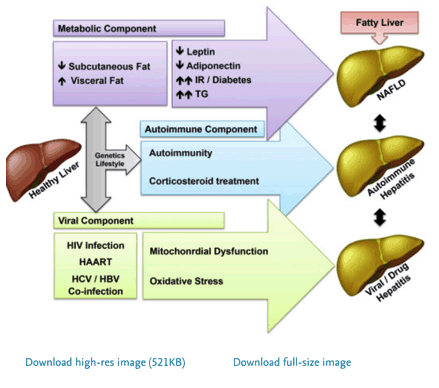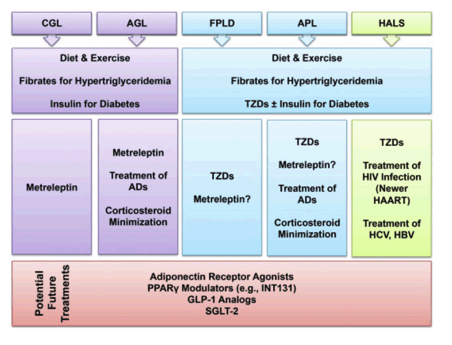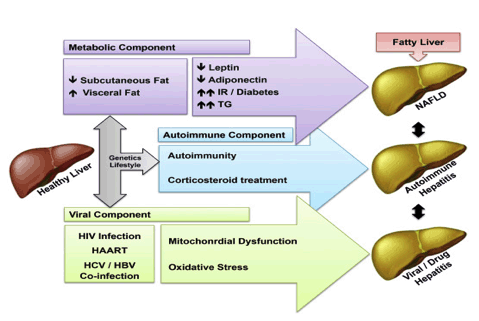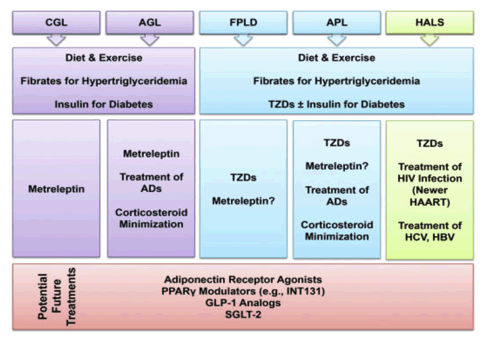| |
NAFLD in lipodystrophy
|
| |
| |
Download the PDF here
Metabolism may 2019 - Stergios A. Polyzos, Nikolaos Perakakis, Christos S. Mantzoros
Fatty liver disease prevalence has found t be double in HIV+ as more risk factors are present including lipodystrophy, metabolic abnormalities, prior old nuke use, diabetes, hyperlipidemia, hypertension, and more. The concern is although in a relatively percent it can progress to advanced liver disease. Jules
Excerpts
Abstract
Lipodystrophy is a group of clinically heterogeneous, inherited or acquired, disorders characterized by complete or partial absence of subcutaneous adipose tissue that may occur simultaneously with the pathological, ectopic, accumulation of fat in other regions of the body, including the liver. Fatty liver adds significantly to hepatic and extra-hepatic morbidity in patients with lipodystrophy. Lipodystrophy is strongly associated with severe insulin resistance and related comorbidities, such as hyperglycemia, hyperlipidemia and nonalcoholic fatty liver disease (NAFLD), but other hepatic diseases may co-exist in some types of lipodystrophy, including autoimmune hepatitis in acquired lipodystrophies, or viral hepatitis in human immunodeficiency virus (HIV)-associated lipodystrophy. The aim of this review is to summarize evidence linking lipodystrophy with hepatic disease and to provide a special focus on potential therapeutic perspectives of leptin replacement therapy and adiponectin upregulation in lipodystrophy.
CROI: Changes in Liver Fibrosis and Steatosis in HIV Mono-Infected patients over 24 months - 50% have fatty liver at average age of 46 - (03/28/17)
CROI: LIVER STEATOSIS AND FIBROSIS IN AT-RISK EUROPEAN HIV-MONOINFECTED PATIENTS - 64% with steatosis among those who had elevated LFTs and/or metabolic syndrome and/or lipodystrophy - (03/28/17)
"acquired lipodystrophy is much more common; especially lipodystrophy associated with the human immunodeficiency virus (HIV) infection and the related highly active antiretroviral therapy (HAART) is currently the most prevalent form (HIV-associated lipodystrophy syndrome; HALS) [1]. Classification of the types of lipodystrophy is presented in Table 1 [5,6]......The extent of fat loss is associated with the severity of IR and the related metabolic abnormalities: patients with severe lipodystrophy have severe IR, severe hyperlipidemia and advanced hepatic disease
HALS: HIV-associated lipodystrophy syndrome
metformin is discouraged in patients with lipodystrophy: Among the oral antidiabetic medications, metformin has been used more frequently in lipodystrophy [15], due to its low cost and long-term availability. Most data for metformin are derived from studies in HALS. Together with a favorable effect on glucose and lipid metabolism [128,137,138], metformin decreased LFTs in some [128], but not all studies (Table 4). It should be underlined that metformin decreased subcutaneous and/or visceral fat [128,137,138]; the decrease in fat mass results in a general IR decrease, which is favorable in non-lipodystrophic T2DM patients but not in those with lipodystrophy. Therefore, metformin is discouraged in patients with lipodystrophy.
Patients with HALS have approximately 2.5-fold more hepatic fat, 2-fold more intra-abdominal fat and 2-fold less subcutaneous fat than non-HIV controls [76,77]. However, hepatic fat content is similar in HIV patients without NAFLD and non-HIV controls [77]. The prevalence of NAFLD in HIV patients varies between 40% and 75% [[78], [79], [80]], largely depending on the diagnostic technique. It is higher than the general population (25-30%) [81], but lower than generalized lipodystrophy. Longer nucleoside reverse-transcriptase inhibitor exposure is positively associated with hepatic disease in HIV [78]. However, the prevalence of NAFLD was higher (65-85%) in the early years of HIV infection, possibly because of malnutrition, concomitant infections and higher hepatotoxicity of older HAART regimens [82]. NASH was reported in approximately 40-70 and cirrhosis in 5-20% of HIV patients [79,80,83]. These rates are somehow lower than those reported in generalized and acquired lipodystrophy, but much higher than those observed in the general population (3-5%) [84].
Lipodystrophy is characterized by ectopic fat accumulation, due to insufficient storage capacity of subcutaneous adipose tissue, and thus to severe insulin resistance (IR), often manifesting by acanthosis nigricans, type 2 diabetes mellitus (T2DM), hyperlipidemia and nonalcoholic fatty liver disease (NAFLD) [7]. NAFLD encompasses nonalcoholic simple steatosis (SS), in which the predominant histological characteristic is lipid accumulation in the hepatocytes, nonalcoholic steatohepatitis (NASH), characterized by the addition of hepatic inflammation, fibrosis, and NASH-related cirrhosis and hepatocellular carcinoma [8]. Apart from its hepatic morbidity, NAFLD has been also associated to extra-hepatic morbidity, including metabolic complications, chronic kidney disease, cardiovascular disease and malignancies, which all contribute to higher mortality, especially observed in NASH patients [[9], [10], [11]].
The aim of this review is to summarize evidence linking lipodystrophy with hepatic disease, and provide a special focus on potential therapeutic perspectives of leptin replacement therapy and adiponectin upregulation in lipodystrophy.
Patients with lipodystrophy lack adipocytes, so they cannot effectively store triglycerides. This limits the disposal of excess dietary triglycerides in the unaffected adipocytes, if any, and subsequently triglycerides are stored ectopically in non-adipose tissues, such as the liver and skeletal muscles [17]. Ectopic fat accumulation in insulin-targeted organs, including the liver, promotes IR and its complications, including NAFLD [8]. This sequence may explain the early stages of NAFLD (hepatic steatosis), but not the subsequent hepatic inflammation and fibrosis [18]. Therefore, lipodystrophy itself may possibly predispose to hepatic steatosis usually at a young age [19], the chronicity of which subsequently drives to hepatic inflammation and fibrosis. However, this remains to be definitely shown.
In common obesity, mature adipocytes exist, but their functional capacity to store triglycerides is eventually saturated. Therefore, when the adipose tissue storage capacity is exhausted, triglycerides are also ectopically deposited and accumulate outside the adipose tissue, including the liver and the skeletal muscle [18,20].
The lipodystrophic patients have severe systemic and hepatic IR, as shown by the distinctly decreased insulin-mediated suppression of glucose production during the hyperinsulinemic clamp (40%) compared with the control subjects (92%) [61]. The extent of fat loss is associated with the severity of IR and the related metabolic abnormalities: patients with severe lipodystrophy have severe IR, severe hyperlipidemia and advanced hepatic disease [7]. Hepatomegaly is commonly observed in patients with lipodystrophy. In a systematic review, the rates of hepatomegaly were 84%, 80%, 54% and 29% in CGL, AGL, FPLD and acquired partial lipodystrophy (APL), respectively [62], being generally higher in generalized than partial syndromes, with the lower rates in APL, in which hepatomegaly is milder or absent [63,64]. Mild to severe elevation of liver function tests (LFTs) are frequently observed [63,65], but LFTs may also be normal, especially in partial syndromes [[66], [67], [68]]. As in non-lipodystrophic NAFLD, LFTs cannot establish the severity of NAFLD."
"Fig. 3. A summary of the main factors contributing to the fatty liver of lipodystrophy. For the needs of presentation the factors have been divided into metabolic, autoimmune and viral components, although both overlap, and cross-talk exist among them. Regarding the metabolic component, which is commonly observed in both congenital and acquired lipodystrophies, the initial condition is subcutaneous lipoatrophy together with increase in visceral fat, which lead to low leptin and adiponectin levels and severe IR, associated with, diabetes and high TG levels. This sequence leads to NAFLD. Regarding the autoimmune component, which is more often present in acquired lipodystrophies, autoimmune mechanisms themselves contribute to autoimmune hepatitis, but also the chronic corticosteroid treatment may further result to drug-induced fatty liver. Regarding the viral component, which is more common in HALS, HIV infection itself, but also HAART mainly through mitochondrial dysfunction and increased oxidative stress lead to viral and/or drug-induced fatty liver. Co-infection with HCV and HBV, commonly observed in HIV-patients, further contribute to fatty liver. Genetics factors and lifestyle contribute to all components.

6. Therapeutic Perspectives of Fatty Liver in Lipodystrophy
SEE FULL SECTION BELOW
Fig. 4. Proposed management of lipodystrophy with potential beneficial hepatic effect. Diet and exercise is regarded as the standard care for all types of lipodystrophy. Fibrates should be used, if needed, for the management of hypertriglyceridemia in all types of lipodystrophy. Insulin should be used for the management of diabetes, if needed, in CGL and AGL, whereas TZDs may be initially used in partial lipodystrophy, including HAALS. Metreleptin seems to be beneficial for the treatment of steatosis and early NASH in patients with CGL and AGL, as well as in those with FPLD and APL. Existing data for metreleptin in HALS are not sufficient to propose for or against its use. Given the limited data, metreleptin use is not proposed for lipodystrophic patients with NASH and advanced fibrosis or cirrhosis (fibrosis stage 3-4), until novel data clarify the efficacy and safety of its use in these patients. In patients with partial lipodystrophy, including HALS, TZDs may exert beneficial effects on the liver, via upregulating adiponectin. In patients with acquired lipodystrophy, ADs, including autoimmune hepatitis, should be managed; the avoidance or minimization of corticosteroid would be beneficial for the liver. In patients with HALS, HIV infection should be managed preferably with newer HAART, considered to be less hepatotoxic. Furthermore, co-existing HCV and/or HBV infection should be managed. In the future, recombinant adiponectin may be used as a replacement treatment, possibly in all types of lipodystrophy, whereas, selective PPARγ modulators (e.g., INT131) may be also investigated.

Growth hormone (GH) deficiency has been associated with both lipodystrophy and NAFLD. HAART in HIV patients alters GH secretion and about one-third of patients have biochemical GH deficiency [143]. Therefore, medications acting on GH axis, including recombinant GH, GH releasing hormone (GHRH) and IGF-1, have been tested for the treatment of HALS [144]. A meta-analysis showed that both recombinant GH and tesamorelin, a GHRH analogue, reduced visceral adipose mass, but only recombinant GH reduced subcutaneous adipose mass [144]. Thus, tesamorelin may be more promising and safer than treatment with recombinant GH for lipodystrophy [143], since the reduction in subcutaneous fat is not desirable in patients with lipodystrophy. The combination of rosiglitazone and recombinant GH may be preferable than GH monotherapy for HALS, since the TZD may abrogate the increase in IR induced by the recombinant GH [145]."
Fatty liver in lipodystrophy: A review with a focus on therapeutic perspectives of adiponectin and/or leptin replacement.
1. Introduction
Lipodystrophy is a group of clinically heterogeneous, inherited or acquired disorders characterized by complete (generalized lipodystrophy) or partial (partial lipodystrophy) absence of subcutaneous fat (lipoatrophy) that may occur simultaneously with the pathological accumulation of adipose tissue (lipohypertrophy) in other regions of the body [1,2]. Congenital lipodystrophy is extremely rare, with approximately 1000 reported cases (familial or sporadic) [3,4]. Based on the assumption that only one fourth of the patients may be reported, the prevalence of congenital lipodystrophy may be estimated to be approximately less than one in a million [4]. On the other hand, acquired lipodystrophy is much more common; especially lipodystrophy associated with the human immunodeficiency virus (HIV) infection and the related highly active antiretroviral therapy (HAART) is currently the most prevalent form (HIV-associated lipodystrophy syndrome; HALS) [1]. Classification of the types of lipodystrophy is presented in Table 1 [5,6].
Lipodystrophy is characterized by ectopic fat accumulation, due to insufficient storage capacity of subcutaneous adipose tissue, and thus to severe insulin resistance (IR), often manifesting by acanthosis nigricans, type 2 diabetes mellitus (T2DM), hyperlipidemia and nonalcoholic fatty liver disease (NAFLD) [7]. NAFLD encompasses nonalcoholic simple steatosis (SS), in which the predominant histological characteristic is lipid accumulation in the hepatocytes, nonalcoholic steatohepatitis (NASH), characterized by the addition of hepatic inflammation, fibrosis, and NASH-related cirrhosis and hepatocellular carcinoma [8].
Apart from its hepatic morbidity, NAFLD has been also associated to extra-hepatic morbidity, including metabolic complications, chronic kidney disease, cardiovascular disease and malignancies, which all contribute to higher mortality, especially observed in NASH patients [[9], [10], [11]]. A distinct difference between NAFLD associated with common obesity and lipodystrophy are leptin levels, which are high in the former [12] and very low in the latter [13]. However, leptin levels may not be low in individuals with partial lipodystrophy, since there is a variable degree of fat accumulation in other parts of the body. Other adipokines, such as adiponectin, are similarly low in obesity-associated [14] and lipodystrophy-associated [13] NAFLD (Fig. 1). Therefore, leptin and/or adiponectin replacement may represent specific therapeutic target(s) for lipodystrophy-associated NAFLD. This may be feasible today, since recombinant human methionyl leptin (metreleptin) has been approved for the treatment of metabolic complications in patients with congenital generalized (CGL) or acquired generalized (AGL) lipodystrophy (non-HIV-associated) in the USA and both generalized and partial lipodystrophy in Japan [15] and Europe (https://www.ema.europa.eu/en/medicines/human/EPAR/myalepta). Other leptin analogues are in various stages of development. Additionally, thiazolidinediones (TZDs) increase adiponectin levels and selective peroxisome proliferator-activated receptor (PPAR)γ modulators (SPARMs), as well as adiponectin receptor agonists are under development.
Patients with lipodystrophy lack adipocytes, so they cannot effectively store triglycerides. This limits the disposal of excess dietary triglycerides in the unaffected adipocytes, if any, and subsequently triglycerides are stored ectopically in non-adipose tissues, such as the liver and skeletal muscles [17]. Ectopic fat accumulation in insulin-targeted organs, including the liver, promotes IR and its complications, including NAFLD [8]. This sequence may explain the early stages of NAFLD (hepatic steatosis), but not the subsequent hepatic inflammation and fibrosis [18]. Therefore, lipodystrophy itself may possibly predispose to hepatic steatosis usually at a young age [19], the chronicity of which subsequently drives to hepatic inflammation and fibrosis. However, this remains to be definitely shown.
In common obesity, mature adipocytes exist, but their functional capacity to store triglycerides is eventually saturated. Therefore, when the adipose tissue storage capacity is exhausted, triglycerides are also ectopically deposited and accumulate outside the adipose tissue, including the liver and the skeletal muscle [18,20]. However, IR and ectopic fat accumulation are usually less severe in common obesity than in generalized lipodystrophy in which the adipose tissue storage capacity is non-existing by definition [21]. The main metabolic and phenotypic abnormalities in CGL vs. obesity are illustrated in Fig. 1.
5. Fatty Liver in Clinical Studies of Lipodystrophy: Associations and Implications
The lipodystrophic patients have severe systemic and hepatic IR, as shown by the distinctly decreased insulin-mediated suppression of glucose production during the hyperinsulinemic clamp (40%) compared with the control subjects (92%) [61]. The extent of fat loss is associated with the severity of IR and the related metabolic abnormalities: patients with severe lipodystrophy have severe IR, severe hyperlipidemia and advanced hepatic disease [7]. Hepatomegaly is commonly observed in patients with lipodystrophy. In a systematic review, the rates of hepatomegaly were 84%, 80%, 54% and 29% in CGL, AGL, FPLD and acquired partial lipodystrophy (APL), respectively [62], being generally higher in generalized than partial syndromes, with the lower rates in APL, in which hepatomegaly is milder or absent [63,64]. Mild to severe elevation of liver function tests (LFTs) are frequently observed [63,65], but LFTs may also be normal, especially in partial syndromes [[66], [67], [68]]. As in non-lipodystrophic NAFLD, LFTs cannot establish the severity of NAFLD. In acquired syndromes (AGL and APL), the possible co-existence of autoimmune chronic hepatitis and the chronic use of corticosteroids [64,65] may further complicate the hepatic manifestation of the disease, since both are closely associated with fatty liver, but the specific contribution of the metabolic (NAFLD), autoimmune (autoimmune hepatitis) and pharmacologic (corticosteroids) components is difficult to estimate.
The full spectrum of NAFLD (simple steatosis, NASH, NASH-related cirrhosis and hepatocellular carcinoma) has been described in lipodystrophy. The median age at diagnosis of hepatic steatosis in a cohort with CGL was 12 years, but it may be diagnosed as early as 6 months [19]. Severe hepatic steatosis was initially described in magnetic resonance spectroscopy (MRS) studies [61,69]. Later, NAFLD was confirmed in studies with liver biopsies. In one of the largest histologically confirmed cohorts (n = 50), 90% of lipodystrophic patients had NAFLD, with 82% having NASH (borderline 20% and definite 62%) [70]. Notably, ballooning, being the hallmark of NASH, was evident in 74% of patients, four patients (8%) had advanced cirrhosis and other four (8%) had autoimmune hepatitis [70]. Similarly high rates of NASH (85-95%) were reported in other histologically confirmed studies [6,71], including those with partial lipodystrophy [72]. These are the highest rates of NASH being recorded in a subpopulation, which is additionally characterized by low weight and body mass index (BMI). Therefore, it seems rational that the most recent guidelines suggest that the diagnosis of NASH in a lean individual should raise the suspicion of lipodystrophy [15]. High rates of cirrhosis have been also recorded even in pediatric populations rendering the hepatic component of lipodystrophy even more alarming. More specifically, three of 53 lipodystrophic patients (6%) had cirrhosis in a pediatric cohort [6]. Notably, although more data are needed, it seems that severe recurrence of NAFLD is observed the first few months after orthotopic liver transplantation [73]. Moreover, sporadic cases of hepatocellular carcinoma have been reported, mainly in patients with prolonged hepatic disease [65]. Notably, one third of deaths in CGL have been attributed to liver diseases (complications of liver cirrhosis or hepatic failure), which results to a mean loss of approximately 40 years of life (mean age of death 24 years) [74].
The severity of NAFLD may depend not only on the type of lipodystrophy, being more severe in generalized lipodystrophy, but also on the specific mutation within the same type. For example, earlier hepatic involvement (median age at diagnosis 3.5 vs. 16.0 years, respectively), higher LFTs, and more severe NAFLD have been described in CGL2 compared with CGL1 patients [19], which is generally in line with more severe metabolic abnormalities observed in CGL2, as mentioned above. Likewise, in patients with FPLD, the degree of steatosis was less severe in the patients with PPARG mutations than those with LMNA mutations [75].
Patients with HALS have approximately 2.5-fold more hepatic fat, 2-fold more intra-abdominal fat and 2-fold less subcutaneous fat than non-HIV controls [76,77]. However, hepatic fat content is similar in HIV patients without NAFLD and non-HIV controls [77]. The prevalence of NAFLD in HIV patients varies between 40% and 75% [[78], [79], [80]], largely depending on the diagnostic technique. It is higher than the general population (25-30%) [81], but lower than generalized lipodystrophy. Longer nucleoside reverse-transcriptase inhibitor exposure is positively associated with hepatic disease in HIV [78]. However, the prevalence of NAFLD was higher (65-85%) in the early years of HIV infection, possibly because of malnutrition, concomitant infections and higher hepatotoxicity of older HAART regimens [82]. NASH was reported in approximately 40-70 and cirrhosis in 5-20% of HIV patients [79,80,83]. These rates are somehow lower than those reported in generalized and acquired lipodystrophy, but much higher than those observed in the general population (3-5%) [84].
An issue that further complicates hepatic disease in HIV patients is the co-infection with hepatitis C virus (HCV) and/or hepatitis B virus (HBV), which are usual. LFTs seem to be higher in HIV/HCV co-infection than HIV mono-infection [85]. Hepatic steatosis and fibrosis were evident in 56% and 91%, respectively, of patients with HIV/HCV co-infection [86], although no definitive conclusion could be drawn for the higher rates of fibrosis than steatosis in this study. Importantly, high rates of cirrhosis were observed in HIV patients co-infected with viral hepatitis (8%). Cirrhosis rates were higher in HIV/HCV (19%) than HIV/HBV (6%) patients, but even higher when multiple hepatitis infections co-existed: 42% in HIV/HCV/HBV and 67% in HIV/HCV/HBV/hepatitis D virus [87], implying that both the type of viruses and multiple viral co-infections affect the disease severity. Compared with HCV mono-infection, patients with HIV/HCV co-infection had approximately 1.5-fold higher odds ratio for fibrosis and 3-fold higher odds ratio for advanced fibrosis; lower CD+ count (indicative of more severe immunodeficiency) was associated with higher fibrosis rates [88,89]. Progression of fibrosis seems to be common in patients with HIV/HCV co-infection, being in a study with paired liver biopsies, fibrosis progressed in 35-45% within 2.5-4.5 years [90] [[91], [92], [93]]. Fibrosis also progresses more rapidly in HIV/HCV than HCV patients [93]. Given that fibrosis is the main histological prognostic factor for advanced hepatic disease [94], HIV/HCV co-infection should be considered as a high risk factor of advanced hepatic disease. Importantly, it remains to be shown the hepatic impact of HIV/hepatitis co-infection specifically in patients with lipodystrophy.
A summary of the main factors contributing to the fatty liver of lipodystrophy is presented in Fig. 3.

Fig. 3. A summary of the main factors contributing to the fatty liver of lipodystrophy. For the needs of presentation the factors have been divided into metabolic, autoimmune and viral components, although both overlap, and cross-talk exist among them. Regarding the metabolic component, which is commonly observed in both congenital and acquired lipodystrophies, the initial condition is subcutaneous lipoatrophy together with increase in visceral fat, which lead to low leptin and adiponectin levels and severe IR, associated with, diabetes and high TG levels. This sequence leads to NAFLD. Regarding the autoimmune component, which is more often present in acquired lipodystrophies, autoimmune mechanisms themselves contribute to autoimmune hepatitis, but also the chronic corticosteroid treatment may further result to drug-induced fatty liver. Regarding the viral component, which is more common in HALS, HIV infection itself, but also HAART mainly through mitochondrial dysfunction and increased oxidative stress lead to viral and/or drug-induced fatty liver. Co-infection with HCV and HBV, commonly observed in HIV-patients, further contribute to fatty liver. Genetics factors and lifestyle contribute to all components.
6. Therapeutic Perspectives of Fatty Liver in Lipodystrophy
Currently, metreleptin, or in the future leptin analogues or leptin receptor agonists, are rational choice(s) for the treatment of lipodystrophy, representing a partial replacement treatment, when endogenous leptin levels are lower than normal. Other medications, especially those that would increase adiponectin levels in a condition characterized by low adiponectin, have also been used or tested in clinical trials. Other classes of medications, acting through other pathways or acting downstream of leptin and/or adiponectin, are currently in trials and may be used for the treatment of lipodystrophy. The hepatic effects of these medications are hereby presented. The proposed management of lipodystrophy with potential beneficial hepatic effect is presented in Fig. 4.

Fig. 4. Proposed management of lipodystrophy with potential beneficial hepatic effect. Diet and exercise is regarded as the standard care for all types of lipodystrophy. Fibrates should be used, if needed, for the management of hypertriglyceridemia in all types of lipodystrophy. Insulin should be used for the management of diabetes, if needed, in CGL and AGL, whereas TZDs may be initially used in partial lipodystrophy, including HAALS. Metreleptin seems to be beneficial for the treatment of steatosis and early NASH in patients with CGL and AGL, as well as in those with FPLD and APL. Existing data for metreleptin in HALS are not sufficient to propose for or against its use. Given the limited data, metreleptin use is not proposed for lipodystrophic patients with NASH and advanced fibrosis or cirrhosis (fibrosis stage 3-4), until novel data clarify the efficacy and safety of its use in these patients. In patients with partial lipodystrophy, including HALS, TZDs may exert beneficial effects on the liver, via upregulating adiponectin. In patients with acquired lipodystrophy, ADs, including autoimmune hepatitis, should be managed; the avoidance or minimization of corticosteroid would be beneficial for the liver. In patients with HALS, HIV infection should be managed preferably with newer HAART, considered to be less hepatotoxic. Furthermore, co-existing HCV and/or HBV infection should be managed. In the future, recombinant adiponectin may be used as a replacement treatment, possibly in all types of lipodystrophy, whereas, selective PPARγ modulators (e.g., INT131) may be also investigated.
.
|
|
| |
| |
|
|
|